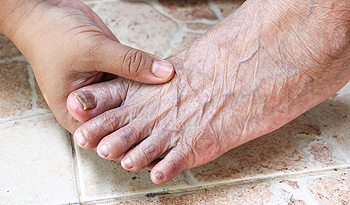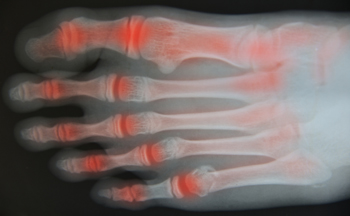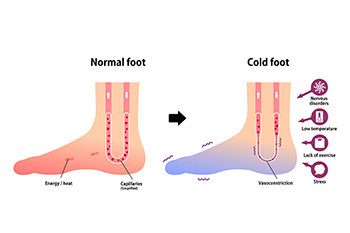April 2023
Facts About Plantar Warts

Plantar warts, also called verruca, are hardened growths that usually develop on the sole of the foot. They appear as rough, grainy, rounded lesions that may be covered by calluses and have tiny black dots. Plantar warts typically cause pain on the ball or heel of the foot, where they are most likely to form. This can affect both the way you stand and your gait, or the way you walk, which in turn can contribute to pain in other body parts. Because plantar warts are contagious, they can easily spread into clusters called mosaic warts. Plantar warts are caused by the human papillomavirus, or HPV, which usually enters through cracked dry skin or small cuts or sores on the feet. Children, teenagers, and people with weakened immune systems are particularly at risk of plantar wart infection. A plantar wart can take up to two years to go away on its own, and for that reason it is suggested that you see a podiatrist who can offer advanced treatment methods, including freezing off the warts and prescription medication.
Plantar warts can be very uncomfortable. If you need your feet checked, contact Dr. Mark Spier from Maryland. Our doctor will assist you with all of your foot and ankle needs.
About Plantar Warts
Plantar warts are the result of HPV, or human papillomavirus, getting into open wounds on the feet. They are mostly found on the heels or balls of the feet.
While plantar warts are generally harmless, those experiencing excessive pain or those suffering from diabetes or a compromised immune system require immediate medical care. Plantar warts are easily diagnosed, usually through scraping off a bit of rough skin or by getting a biopsy.
Symptoms
- Lesions on the bottom of your feet, usually rough and grainy
- Hard or thick callused spots
- Wart seeds, which are small clotted blood vessels that look like little black spots
- Pain, discomfort, or tenderness of your feet when walking or standing
Treatment
- Freezing
- Electric tool removal
- Laser Treatment
- Topical Creams (prescription only)
- Over-the-counter medications
To help prevent developing plantar warts, avoid walking barefoot over abrasive surfaces that can cause cuts or wounds for HPV to get into. Avoiding direct contact with other warts, as well as not picking or rubbing existing warts, can help prevent the further spread of plantar warts. However, if you think you have developed plantar warts, speak to your podiatrist. He or she can diagnose the warts on your feet and recommend the appropriate treatment options.
If you have any questions please feel free to contact one of our offices located in Columbia and Reisterstown, MD . We offer the newest diagnostic and treatment technologies for all your foot and ankle needs.
Routine Foot Care Tips for Elderly People

Foot pain for various reasons can be common among the senior population. Some of these can include a loss of padding in the heel area as the aging process happens or from existing medical conditions. Diabetes, poor circulation, and arthritis can be common conditions among people in this age bracket, and this may lead to developing foot problems. Practising a good foot care routine is beneficial which may help prevent unwanted foot conditions. This can begin with washing and drying the feet daily, then inspecting the soles using a mirror. This is helpful in noticing any existing cuts, bruises, and scrapes. Additionally, trimming the toenails weekly may help to avoid an ingrown toenail from occurring. If you would like more information about elderly foot care, it is suggested that you confer with a podiatrist who can address any questions you may have.
Proper foot care is something many older adults forget to consider. If you have any concerns about your feet and ankles, contact Dr. Mark Spier from Maryland. Our doctor can provide the care you need to keep you pain-free and on your feet.
The Elderly and Their Feet
As we age we start to notice many changes in our body, but the elder population may not notice them right away. Medical conditions may prevent the elderly to take notice of their foot health right away. Poor vision is a lead contributor to not taking action for the elderly.
Common Conditions
- Neuropathy – can reduce feeling in the feet and can hide many life-threatening medical conditions.
- Reduced flexibility – prevents the ability of proper toenail trimming, and foot cleaning. If left untreated, it may lead to further medical issues.
- Foot sores – amongst the older population can be serious before they are discovered. Some of the problematic conditions they may face are:
- Gouging toenails affecting nearby toe
- Shoes that don’t fit properly
- Pressure sores
- Loss of circulation in legs & feet
- Edema & swelling of feet and ankles
Susceptible Infections
Diabetes and poor circulation can cause general loss of sensitivity over the years, turning a simple cut into a serious issue.
If you have any questions please feel free to contact one of our offices located in Columbia and Reisterstown, MD . We offer the newest diagnostic and treatment technologies for all your foot and ankle needs.
Facts About Rheumatoid Arthritis

Rheumatoid arthritis, or RA, is an auto-immune disease that causes pain, swelling, and stiffness in the joints. The feet, which contain multiple joints, are often affected by this inflammatory condition. The immune system, instead of protecting the joints, sends antibodies into the lining of the joints causing the tissue surrounding the joint to become inflamed. This results in damage to the bones, tendons, ligaments, and cartilage. Many people are affected by RA, but most develop it between the ages of 40 and 50. Women are three times more likely to have rheumatoid arthritis than men, largely due to hormonal differences. Also, it affects many people who smoke or have a genetic tendency toward the disease. RA causes throbbing and aching pain, and may induce fatigue and fever along with a loss of appetite. Rheumatoid arthritis is not curable, but measures may be taken to reduce the symptoms. If you think you may have RA that is affecting your feet, it is suggested that you consult a podiatrist for treatment options.
Because RA affects more than just your joints, including the joints in your feet and ankles, it is important to seek early diagnosis from your podiatrist if you feel like the pain in your feet might be caused by RA. For more information, contact Dr. Mark Spier of Maryland. Our doctor will assist you with all of your podiatric concerns.
What Is Rheumatoid Arthritis?
Rheumatoid Arthritis (RA) is an autoimmune disorder in which the body’s own immune system attacks the membranes surrounding the joints. Inflammation of the lining and eventually the destruction of the joint’s cartilage and bone occur, causing severe pain and immobility.
Rheumatoid Arthritis of the Feet
Although RA usually attacks multiple bones and joints throughout the entire body, almost 90 percent of cases result in pain in the foot or ankle area.
Symptoms
- Swelling and pain in the feet
- Stiffness in the feet
- Pain on the ball or sole of feet
- Joint shift and deformation
Diagnosis
Quick diagnosis of RA in the feet is important so that the podiatrist can treat the area effectively. Your doctor will ask you about your medical history, occupation, and lifestyle to determine the origin of the condition. Rheumatoid Factor tests help to determine if someone is affected by the disease.
If you have any questions please feel free to contact one of our offices located in Columbia and Reisterstown, MD . We offer the newest diagnostic and treatment technologies for all your foot and ankle needs.
Cold Toes May Indicate Raynaud’s Phenomenon

A condition known as Raynaud’s phenomenon is a circulatory problem that causes the blood vessels in the extremities to narrow and restrict blood flow. This can cause the toes to become cold and even turn blue. There are two types of Raynaud’s phenomenon, primary and secondary. Primary has no known cause, but secondary may occur in conjunction with another underlying condition, such as lupus or rheumatoid arthritis. This type is far more serious and can lead to the formation of skin ulcers that may become gangrenous if ignored. Women are more at risk for Raynaud’s phenomenon, and it usually occurs in people in their 30s or younger. Emotional stress and smoking also can trigger attacks. When an attack occurs, the toes become exceedingly cold and may change color, which can evolve into burning and tingling when the toes finally get warmer. If you are having increasing problems with coldness and discoloration in the toes, it is suggested that you meet with a podiatrist who can properly diagnose your condition and offer treatment options.
While poor circulation itself isn’t a condition; it is a symptom of another underlying health condition you may have. If you have any concerns with poor circulation in your feet contact Dr. Mark Spier of Maryland. Our doctor will treat your foot and ankle needs.
Poor Circulation in the Feet
Peripheral artery disease (PAD) can potentially lead to poor circulation in the lower extremities. PAD is a condition that causes the blood vessels and arteries to narrow. In a linked condition called atherosclerosis, the arteries stiffen up due to a buildup of plaque in the arteries and blood vessels. These two conditions can cause a decrease in the amount of blood that flows to your extremities, therefore resulting in pain.
Symptoms
Some of the most common symptoms of poor circulation are:
- Numbness
- Tingling
- Throbbing or stinging pain in limbs
- Pain
- Muscle Cramps
Treatment for poor circulation often depends on the underlying condition that causes it. Methods for treatment may include insulin for diabetes, special exercise programs, surgery for varicose veins, or compression socks for swollen legs.
As always, see a podiatrist as he or she will assist in finding a regimen that suits you. A podiatrist can also prescribe you any needed medication.
If you have any questions, please feel free to contact one of our offices located in Columbia and Reisterstown, MD . We offer the newest diagnostic and treatment technologies for all your foot care needs.










